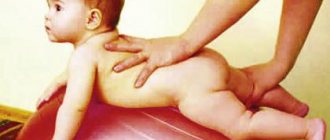Many mothers note that their children, lying on their backs, turn their heads only to one side. In the first days after discharge from the maternity hospital, this is not so noticeable, because young parents are just getting used to their responsibility and do not notice the baby’s peculiarities. After some time, adults notice that the child begins to arch unnaturally or categorically refuses to turn his head to the other side.
The baby's head is on the side
Description
More than half of parents notice that their child turns his head to one side. Moreover, at the same time, the chin is directed in the opposite direction. This condition is called torticollis. It can be congenital and acquired.
Often, due to the baby being in one position, the head becomes flattened. The deformation occurs on the side on which the child most often lies. Without treatment, torticollis can lead to blurred vision and strabismus. Often the disease is combined with other disorders, such as hip dysplasia. Early diagnosis is critical in the treatment of such conditions.
How to determine if a child has torticollis
Torticollis does not appear immediately. In the first days and even weeks of life, the newborn freely turns his head to the sides. But already from the third week you can notice that the child does not hold it straight: the head is always turned to one side, maybe slightly tilted. When you try to turn his head in the other direction, the baby may worry, cry - these actions will cause him discomfort or even pain.
An experienced specialist will be able to feel the thickening on one side of the sternocleidomastoid muscle. This is the muscle that is responsible for nodding, tilting and turning the head.
It is important!
The longer the disease develops without treatment, the stronger its symptoms will appear: changes in the affected muscle will become obvious not only to the doctor, the child’s head will be fixed in one position, deformation of the skull will begin and facial asymmetry will appear.
Fortunately, such severe consequences can be successfully avoided: in most cases, with timely treatment, torticollis disappears without a trace within a few months.
Causes
There are many factors that cause a baby to turn its head to one side. The most common causes of muscular torticollis are:
- birth trauma (use of vacuum extraction, forceps, improper pulling of the baby during childbirth, use of force, physical impact on the uterus);
- improper intrauterine formation of the spine;
- congenital muscle developmental abnormalities;
- intrauterine problems (excess uterine tissue can cause muscle shortening);
- breech (pelvic) presentation of the baby.
In rare cases, torticollis may develop due to oblique palsy or abnormalities of the cervical spine. In this case, the disease may be a symptom of genetic abnormalities.
Acquired forms of the condition, when a child turns his head to one side, can occur for the following reasons:
- strabismus;
- hearing impairment;
- tonsillitis;
- tumor;
- burn;
- injury;
- diseases of the nervous system;
- long-term position in a car seat, stroller, etc.,
- severe gastroesophageal reflux disease;
- scoliosis.
Symptoms of torticollis
Torticollis is an incorrect forced position of the cervical spine.
Torticollis in infants is a pathology in which the head takes a forced incorrect position. It will be constantly tilted to one side. The development of the disease is caused by pathological changes in the soft tissues and skeleton. Very often, torticollis develops as a result of a birth injury. If a child’s neck is turned to one side, this indicates improper formation of the cervical vertebrae and the sternocleidomastoid muscle.
Muscular torticollis in newborns is a disease of the musculoskeletal system, which ranks third in prevalence. According to statistics, up to 2% of infants suffer from it. Girls are at risk. They are the ones most often diagnosed with the disease.
The danger of the pathology lies in the fact that the child is limited in physical development. The disease is accompanied by impaired functioning of the organs of hearing and vision, and the baby exhibits psychological abnormalities. Torticollis will not go away on its own; it should not be left without medical attention. If adequate treatment is not prescribed, in the future this will cause an irreversible process of deformation of the vertebrae, which can cause disability.
Dr. Komarovsky claims that it is very easy to notice the signs of torticollis in newborns:
- the child constantly turns his head only in one direction;
- it is difficult for a newborn to keep his head straight;
- head tilts are directed only to the left or to the right.
The child constantly keeps his head tilted
The head is constantly tilted towards the shoulder, this can cause facial asymmetry. It is difficult for the baby to move his head; it seems to be fixed in one wrong position.
During the initial examination, you may find that the neck on the side where the child turns his head becomes stiff. This is very well felt upon palpation. Depending on the location of torticollis, it can be:
- left-handed;
- right-sided;
- bilateral.
If you do not seek help from a specialist when the first signs of the disease are detected, over time you may experience:
- formation of soft tissue compactions in the neck;
- disproportionate development of the shape of the skull;
- asymmetry of parts of the face;
- change in neck size, it becomes shorter on one side.
Not only the neck, but also the collarbone and shoulders are subject to deformation. This leads to the fact that the child will not be able to keep his head upright. As the disease develops, the baby develops scoliosis.
Symptoms in infants
The classic sign of torticollis is that the child constantly turns his head to one side. However, parents may notice other symptoms. These include:
- The child always turns his head to one side. For example, if a baby has right-sided torticollis (the head is tilted to the right), then he will always move his head to the left. If he needs to look to the right, the child will turn his whole body in this direction.
- The baby's head may be tilted back.
- The baby prefers one breast when feeding. Because torticollis causes a limited range of head movement, the baby may have trouble latching onto the breast. In such cases, the child turns his head to one side, from which it is more convenient for him to complete the feeding process. There may be no specific changes in behavior, such as fussing or crying.
- Swelling of the neck muscles. If the child has had a muscle injury, parents may notice a small lump about the size of a pea on the muscle. The presence of such a lump indicates the formation of scar tissue.
- Facial asymmetry. One side may be skewed and the eye may be squinted.
- Incorrect body position. Shoulders can be located at different levels.
- Curvature of the occipital part of the head.
How to determine torticollis in a newborn
Despite the fact that the vast majority of newborns have a “favorite” side for turning their head, not all are diagnosed with torticollis. It is known that among all children with torticollis, 55% are boys. This diagnosis is considered third on the list of common congenital diseases, second only to hip dislocation and clubfoot.
Urine analysis according to Sulkovich in an infant, which shows how to collect urine
Signs on the basis of which a diagnosis of torticollis is made:
- the child’s head not only turns in one direction only, but also has a constant tilt;
- upon palpation, a violation of the tissue of the muscle located on the side of the inclination is detected;
- there is asymmetry of the face and skull - slow vertical growth of bones on the side of the inclination;
- attempts to tilt the head in the other direction cause pain;
- the initial stage of scoliotic changes in the spine is observed.
Attention! If a child, lying on his back, always turns his head in only one direction, but there is no tilt towards the shoulder, this is not torticollis, but asymmetrical growth of the skull bones due to intrauterine constraint. Such problems disappear as the skull grows without medical intervention.
Turning to one side is not torticollis
Infant examination
A mother must undergo a routine examination with her baby at 1, 3, 6 months and a year. Parental responsibility can save a child from disability if at the age of 1 month the mother remembers to visit an orthopedist. A specialist can detect shortening of the neck muscle in the early stages and prescribe therapy that will cure the baby.
During the examination, the orthopedist performs what the parents consider to be frivolous manipulations:
- bends and extends the joints of the legs and arms;
- evaluates the symmetry of the folds located below the popliteal cavities;
- palpates the neck muscles.
Parents of healthy children feel that visiting an orthopedist was a waste of time. They didn’t notice anything special in the doctor’s manipulations: he laid the baby on his stomach, then on his back, stroked something, felt something and wrote on the card that the baby was healthy. But these seemingly simple movements help to diagnose serious abnormalities, including torticollis. It is careful palpation of the muscles that helps to detect compactions that have formed as a result of birth trauma.
Important! If measures are not taken in time, the seals turn into scars that shorten the muscle. Only surgery can treat tissue scarring.
If the doctor has detected some changes in the homogeneity of the muscle tissue, and, according to the mother, the child always looks in one direction, the doctor may prescribe an additional ultrasound examination of the cervical spine to make sure the diagnosis is correct.
X-rays, as a rule, are not prescribed for infants. Infants do not allow us to take a clear picture because they cannot lie still with their heads thrown back with their mouths open, as required by the radiologist.
Ultrasound diagnostics
Diagnostics
To diagnose and evaluate the condition in which the baby turns his head to one side, you may need to undergo the following tests:
- Visual and physical inspection. This is the easiest way to determine torticollis when examining a child. The doctor may feel some resistance while turning the baby's head. If the baby's neck muscle was injured during childbirth, the doctor will look for any outward signs of scar tissue formation. Examining your baby immediately after birth and a few days later can help detect torticollis at an early stage. In the case of an acquired form of the disease, doctors look for symptoms of other abnormalities that caused torticollis.
- X-ray. The examination gives a clear picture of the structure of the bones. Using an x-ray, you can detect the presence of torticollis or any other problem associated with the baby’s skeleton.
- Ultrasound. An ultrasound scan uses high-frequency sound waves to create precise images of muscles and blood vessels. By assessing the resulting picture, the doctor can accurately say whether the muscles are suffering from torticollis.
Komarovsky about torticollis in infants
A doctor of the highest category, pediatrician Komarovsky, is sure that treatment cannot be delayed. After timely diagnosis, you should begin searching for a massage therapist. The doctor believes that the mother’s task is not just to find a specialist who will conduct massage sessions. The smartest thing to do is find someone who can teach mom the technique. This will save money and provide treatment every day, regardless of the massage therapist’s work schedule. Only in severe forms of the disease should you completely trust the master.
Recovered child
Torticollis is not a death sentence. Timely contact with an orthopedist guarantees a positive outcome. Conservative treatment is most often enough to enable the child to turn to the affected side without difficulty. If the mother is less nervous and smiles more, the baby will recover even faster.
Infant examination
A series of tests when a newborn turns their head to one side may be done to diagnose infantile torticollis, including:
- CT scan of the child's neck;
- Brain MRI;
- EMG to determine which muscles in the neck are affected.
The physical examination looks for signs of shortening of the neck muscles, as well as observing the child's behavior. Usually, with torticollis, the baby turns his head in one direction, and his chin points in the opposite direction.
Treatment
With regular screening and early detection, the disease is quite treatable. If the baby turns his head to one side, comprehensive massage and physical therapy are usually prescribed to correct this condition. This treatment allows you to stretch and strengthen the neck muscles.
Regular physical therapy exercises help the child move his head in different directions, rather than just one, thereby creating balance. In most cases, children's condition can improve within a few weeks or months with therapy. It is also recommended to do daily exercises at home to strengthen it.
For adults and older children, the following treatments may be recommended:
- physical therapy (physical therapy);
- physiotherapy;
- drug therapy;
- surgery to remove the affected muscles;
- wearing a collar;
- physiotherapy,
- sleep on orthopedic pillows and mattresses.
Other pathologies
If your baby has moderate or severe torticollis, parents may notice significant changes in the shape of their head. When a child turns his head to one side more, you may notice some flattening of the skull.
In this case, it is recommended to monitor the baby's position more carefully. It is necessary to turn the child over in the crib while sleeping, place a cushion under the backrest, and also hang bright toys on the “unloved” affected side. You can also put your child to sleep facing the wall, thereby creating an incentive to turn his head in the required direction.
It is worth noting that in addition to torticollis, tilting the head to one side may indicate other diseases and abnormalities, for example:
- Klippel–Feil syndrome. This is a hereditary autoimmune disease in which there is a malformation of the cervical and upper thoracic vertebrae, which is expressed by the patient having a short and inactive neck.
- Pterygoid neck is a developmental anomaly associated with the presence of skin folds on the lateral surfaces of the neck.
- wedge-shaped vertebrae and hemivertebrae are a congenital developmental anomaly, less commonly formed as a result of injuries, tumors, granulomatous and infectious diseases.
- Cervical rib syndrome and costoclavicular syndrome. This congenital disorder is characterized by the presence of additional ribs on both sides of the cervical spine.
- Grisel's disease is a persistent contracture of the muscles attached to the first cervical vertebra, caused by inflammation of the retropharyngeal lymph nodes. The disease is manifested by a forced position of the head, tilted to one side and turned in the opposite direction.
Recommendations
How to prevent and correct a condition in which a child turns his head to one side? To do this, it is recommended to follow some preventive and corrective measures.
- It is necessary to alternate the position of the child during daytime and nighttime sleep. After each feeding, it is recommended to place the baby on the other side. As babies grow older, they begin to turn their heads toward light, bright objects, or to look for their mother. Therefore, with constant alternation of position, the child will turn equally in both directions.
- During wakefulness, it is necessary to place the baby on his tummy. This position helps relieve tension. It will also help strengthen the muscles of the neck, arms, and upper body. Thus, as the child develops, he will learn to roll over, sit and crawl. First, you need to place the baby on his tummy several times for a short period of time. Then the intervals should be reduced and the duration of the exercises should be increased. Place a bright rattle opposite the baby, thereby creating an incentive to raise his head. The best time to lay on the stomach is before or an hour after feeding, after changing a diaper, and after taking water procedures. You can also lie on your back and place your baby on top of you, tummy down. The head should be on the chest. Hearing conversation or singing, the child will want to raise his head and see what is happening.
- It is not recommended to leave your baby in a car seat, baby carrier or swing for long periods of time. Staying in one position for a long time creates tension not only in the neck muscles, but throughout the entire body. The child needs to move: turn his head in different directions, stretch and move his arms or legs.
- It is necessary to start each new feeding from the other breast. In cases of artificial feeding, it is recommended to change the position of the baby, alternately turning one side towards you, then the other. This way, the baby's neck muscles will be trained in both directions equally.
By following the recommendations described above, you can avoid and correct the condition of torticollis in a child.
Risk factors and consequences
Statistics show that breech or transverse presentation of the fetus increases the risk of torticollis. With correct (cephalic) presentation, injury to the sternocleidomastoid muscle can occur due to the following factors:
- narrow pelvis of a woman in labor;
- the use of forceps and other devices with which obstetricians speed up delivery;
- stimulation of labor during weak contractions.
As a rule, the risk of torticollis increases the pathological course of pregnancy, accompanied by oligohydramnios, severe toxicosis or the threat of miscarriage. Multiple pregnancies are also considered a risk factor.
Important! If by the due date the baby, while in the womb, is in no hurry to take the correct position, head down, the expectant mother should be prescribed a course of relaxing drips that reduce the tone of the uterus. As a complex therapy, a pregnant woman needs to remain in the knee-elbow position for 15-20 minutes several times a day.
Although a large percentage of torticollis is a consequence of birth injuries due to breech or transverse presentation, babies born by cesarean section can also suffer from this problem. Infectious intrauterine diseases make torticollis possible due to inflammation pinching the cervical nerve.
If no treatment is attempted, the child may become disabled due to secondary scoliosis. It develops as a result of asymmetrical growth of the bones of the skull and face. Outwardly, such a child will clearly stand out among his peers. Torticollis forces the head to be held in one position, which causes abnormalities in the development of the spine. The result may be a disruption of the blood supply to the brain, since the cervical spine reduces the capacity of the arteries.
Perspective
The sooner a condition in which an infant turns his head to one side is detected and treated, the sooner progress can be made and serious complications can be prevented. Experts say that infants are much easier to treat compared to adults. In cases where the above treatments are not effective, the child may develop prolonged tingling and numbness in the affected area. In addition, chronic muscle swelling may occur due to constant pressure. In severe cases, the child may develop scoliosis.
It is worth noting that most cases of infantile torticollis are successfully treated. According to studies, regular exercise, massage and prevention help 97% of babies.











